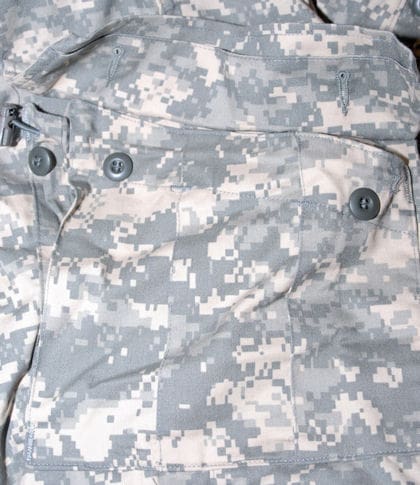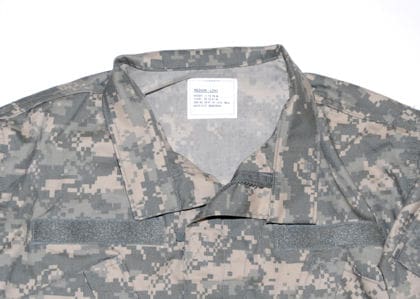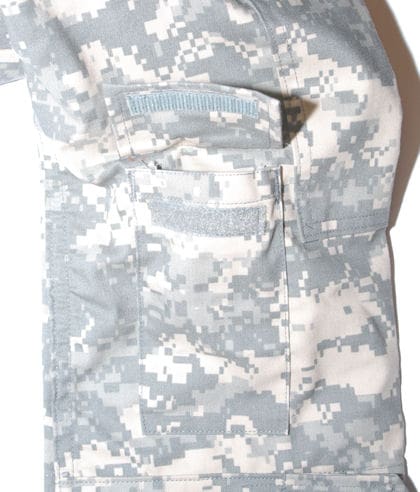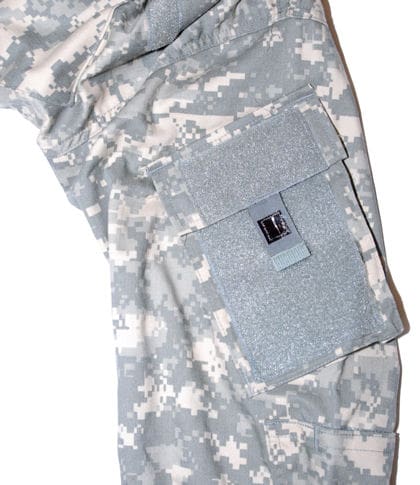ACU Improvements
Over the last year PEO-Soldier’s Program Manager for Soldier Protection and Individual Equipment has undertaken a major project to make incremental improvements to the ACU. In an interview earlier this week with LTC Mike Sloane (Product Manager Soldier Clothing and Individual Equipment), Mr. Todd Wendt (Deputy Product Manager Soldier Clothing and Individual Equipment) and Mr. Fred Coppola (Deputy Project Manager Soldier Protection and Individual Equipment), we discussed these new changes.
Working hand in hand with the Infantry School and based on information collected during post-deployment surveys PEO-Soldier began to take a look at several issues concerning the ACU. These included excessive wear in the crotch of the trousers, concerns over the hook and pile tape closure on the trouser cargo pockets, appearance of the collar, as well as issues with exposed ink pens in the lower sleeve pen pocket. Additionally, they wanted to improve the IR tab attachment.
In order to assess proposed solutions, PEO-Soldier conducted a test of over 1500 Soldiers at Fort Bliss and Fort Carson wearing two prototype designs labeled “A” and “B”. Based on data collected during the wear test, Soldier satisfaction surveys, and cost analysis, PEO-Soldier nominated several improvements for the ACU to the Army Uniform Board. According to Mr. Todd Wendt, an important factor is that all of the changes had to be subtle and not outwardly change the overall appearance of the ACU.
Crotch Reinforcement
To remedy the issues with the crotch, PM-SCIE looked back to the BDU. It seems that sometimes older is better. Minor changes including additional material and thicker stitches have satisfied this, the most common shortfall of the early issue ACU.
Cargo Pockets
Although considered, snaps were rejected along with the current hook and pile tape closures for the cargo pockets. Instead, the ACU Trouser will now feature three buttons per pocket. This remedies premature wear of the hook and pile tape, particularly in combat, and keeps bulky loads more secure.
Collar Appearance
While the original mandarin collar design didn’t negatively affect the combat performance of the ACU, it was pretty annoying in garrison areas. Many a Soldier tried with desperation to get it to lay flat. With a simple pattern improvement, the new collar looks just as good when worn up or down. Although not specifically a collar issue, PEO-Soldier officials also decreased the size of the hook and pile tape that keeps the flap at the front of the ACU coat closed. This change results in both cost and weight savings, however slight, and aids in the collar opening laying flat.
Pen Pockets
There have been many concerns raised from the field regarding the pen slot located near the cuff of the ACU coat. The open top can result in pen clips catching on items which is a bit of a safety issue not to mention plain old annoying. To rectify the situation, they have tested two solutions, both with a flap. One has a recessed pocket and the other has the to of the pocket go all the way to the flap. As either of these solutions will cause an increase in the cost of the ACU, the Army is taking a look at how best to solve the issue and whether they can offset the cost in some other way. Consequently, modifications to the pen pocket were not integrated into this latest round of changes.
However, the ACU now has a pen slot in the front flap of the ACU coat similar to the one in the BDU. I had to pick on the team at PM SCIE and tell them that the Air Force has FOUR pen slots on the ABU and that there was a “pen slot gap” that needed fixing.
Improved IR Tab Attachment
Originally, the IR reflective tabs were sewn directly to the hook and pile tape on the flap of the upper arm pockets of the ACU coat. When not needed, it was covered by a one inch wide flap attached behind the pocket flap. As you can see in the photo, the new design moved the IR tab to the inside of the flap so when it is needed it is pulled down for use. A major advantage to this new design is that it is easier to repair as well as demil in the event the coat is no longer serviceable.
Now that we’ve seen the changes, let’s take a look at how a sampling of these improvements fared during feedback at the end of the trials.
Feature and Percentage of Positive Responses
Reshaped collar to lie flat 95%
Lower hook and loop closure at the collar 86%
Reduced hook and loop tape for the zipper flap 85%
Added flap on lower sleeve pen pocket 80%
Pen sleeve added inside coat front 78%
Moved glint tab to sleeve pocket ribbon tab 75%
Conclusion
These changes have already been approved by the Army Uniform Board and integrated into the Technical Data Package for the ACU so troops should begin to see them by 1st Quarter of FY 2010. All of these changes were cost neutral meaning the alterations resulted in no additional cost to the uniform. This is very important considering that a change that costs as little as one dollar adds up very quickly when you consider the size of the Army and number of ACUs in the clothing bag. You could be looking at millions of dollars. Further improvements to the ACU are under evaluation including a decision on the lower arm pen pocket flap.
One important change that is still under consideration is the possible replacement on the cuff of hook and pile tape for buttons. Currently, the hook and pile tape offers infinite adjustment. There is concern that replacement of the wrist closure with buttons could result in a situation where in an IED event a loose sleeve would create a “tunnel effect” venting flame and hot gas into the uniform. Until this issue is explored fully, PEO-Soldier will not make any recommendations.
Finally, it is important to note that the ACU and Fire Resistant ACU share exactly the same design with the minor exception of the additional one inch x one inch tabs affixed to the left sleeve cuff on the coat, and the left cargo pocket flap of the trouser to readily distinguish them from standard ACUs. This means that all of the improvements to the ACU will also be found on the FR-ACU.
I want to thank LTC Mike Sloane, Mr. Todd Wendt, Mr. Fred Coppola, and Ms. Margaret Roth for their time and assistance in preparing this report.














































































































